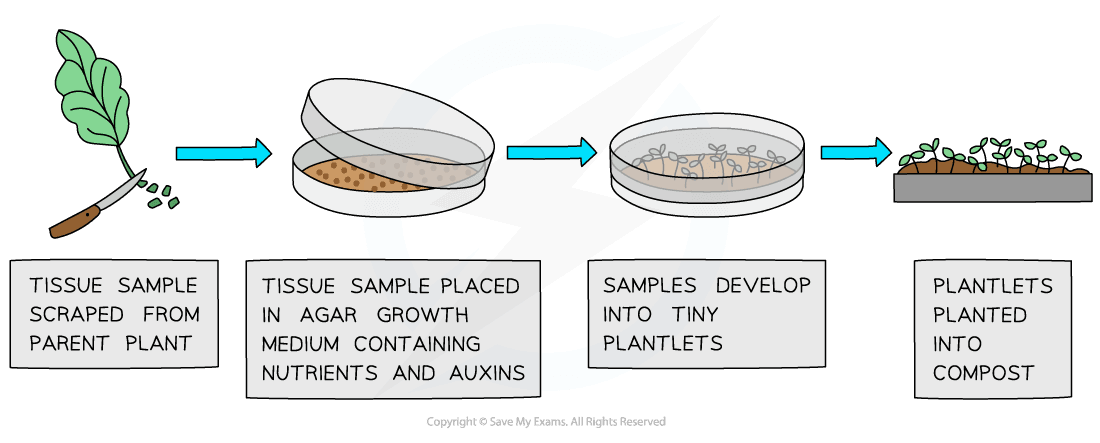Tissue Cultures
- Tissue culture is a process in which very small pieces of organisms (‘tissues’) are grown (‘cultured’) using nutrient media (i.e. in some kind of artificial growth medium)
- This allows scientists to produce a large amount of tissue from just a single individual organism
- This tissue can then be used for a variety of different purposes
Plant tissue culture
- Using tissue culture, whole plants can be grown from a very small amount of plant tissue
- New plants are produced via tissue culture in the following way:
- A parent plant is chosen (this should have the desired characteristics e.g. beautiful flowers, interesting shaped leaves or a large fruit crop)
- A very small amount of tissue (usually a small group of cells) is scraped from the parent plant (these small pieces of tissue are known as explants)
- Under aseptic (sterile) conditions, the tissue pieces are transferred to a sterile petri dish containing nutrient agar. This step must be done under aseptic conditions to prevent the growth of microbes that might harm the plant
- Hormones (e.g. auxins) are added to encourage the cells of the explants to grow
- The explants continue to grow and eventually form plantlets that can be transferred to individual potting trays with compost, where they can develop into plants

Tissue culture: using small groups of cells from a part of a plant to grow identical new plants
- The plants produced via tissue culture are all clones (genetically identical individuals)
- The cloning of plants has many important commercial uses (mainly in plant breeding programmes)
- It allows a variety of a plant with desirable characteristics (e.g. pesticide resistance, good tasting fruit etc.) to be produced:
- Cheaply
- With a greater yield (a large number of plants can be produced)
- In a small space
- Quickly
- At any time of the year
- It can also ensure diseases prevalent in other areas of the world are not imported and spread by ensuring native varieties of plants are produced in large enough quantities to supply demand in one country without importing plants from abroad
- Plant tissue culture can also play an important role in preserving rare plant species
Animal tissue culture
- Genetically identical animal cells and tissues can be produced in large quantities via a slightly different tissue culture process:
- A sample of the tissue to be studied (e.g. tissue from the pancreas) is extracted from the animal
- Enzymes are used to separate the cells that make up the tissue sample
- The cells are placed in a culture vessel (i.e. some kind of container) along with a growth medium
- This contains all the nutrients needed for the cells to grow and multiply into tissues
- Once the tissue culture has been grown, it can be stored for future use
- Animal tissues grown via tissue culture can be used in medical research:
- For example, the effect of glucose on pancreatic cells can be tested on samples of pancreatic tissue grown via tissue culture
- This means that experiments can be conducted on tissues in isolation, without negatively affecting a living organism
- For example, scientists can study the effects of a particular chemical or environmental change on the cells of a single tissue without complications and external factors caused by other processes that would normally occur in the whole organism

